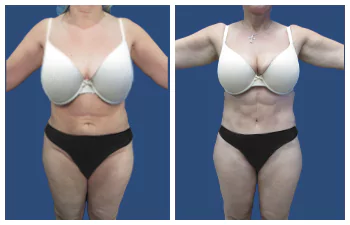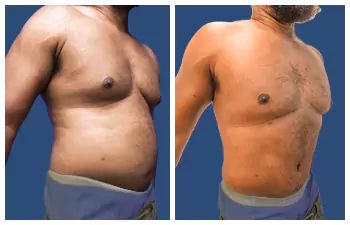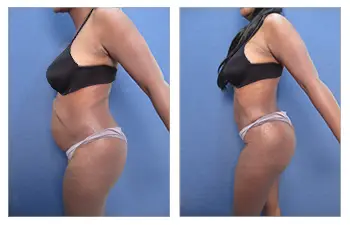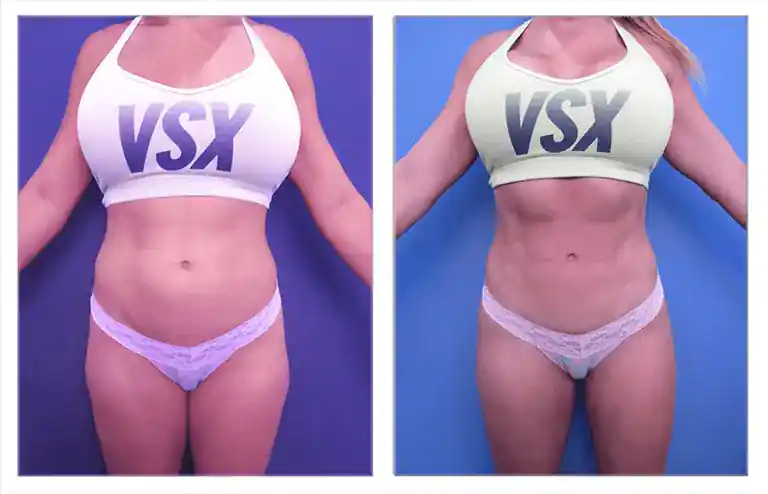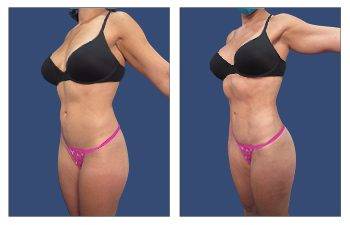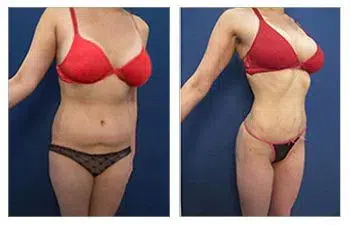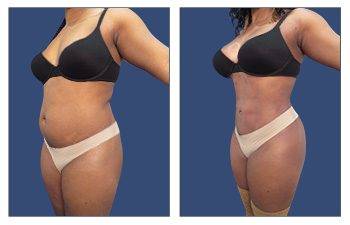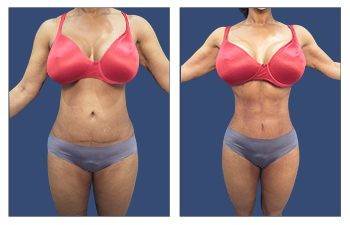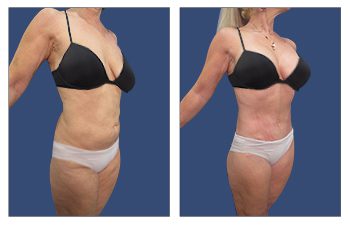“How long does liposuction last?” is a common question that we are asked at our high-definition body contouring centers. This surgery involves the removal of fat from areas of prominence. Fat removed during liposuction cannot return because the fat is eliminated from your body!
However, both weight loss and weight gain can affect your liposuction results for a long time. After eliminating fat from undesirable areas, weight gain will not affect the area treated as much as any neighboring areas where excess body fat cells may still exist. Similarly, when you lose weight, the areas that have been liposuctioned will minimally change in prominence; instead, areas not treated by liposuction with a higher fat density will reduce in prominence.
This is why it is important to treat all concern areas so that all areas of your body maintain a constant density of fat cells. This premise is one of the principles of high-definition body contouring that advocates 360 liposuction, describing the elimination of fat in a circumferential manner to normalize the density of fat throughout your body.
When fat density is normalized throughout your body, you are protected from undesirable contour changes if you experience weight fluctuation. How long does liposuction last? It depends on multiple factors, including your body habitus, the extent of liposuction performed, and your dietary and lifestyle choices.
Let us discuss ab liposuction as an example. When you liposuction fat from the belly, it is important to consider if you should remove fat from your love handles as well. If you store fat in your love handles and gain weight, you may develop overly prominent love handles that contrast with a stable abdominal region.
This observation stresses the importance of considering the treatment of all concern areas since people may struggle with fat cell prominence in several areas. When eliminating fat from your body with a liposuction procedure, expect the results to last based on multiple factors.
Understanding Liposuction and its Long-Term Effects
Liposuction is a popular cosmetic procedure designed to contour the body by removing excess fat from specific areas. Fat cells removed during liposuction don’t regenerate, so the effects can be long-lasting if you maintain weight.
The American Society of Plastic Surgeons reports that this procedure’s outcomes are permanent, given the singular nature of fat cells.
The Science Behind Fat Cells and Liposuction
Your body’s number of fat cells becomes fixed in adolescence. When you gain weight, these cells expand rather than increase in quantity. Therefore, when liposuction removes some of these cells from an area like your thighs or hips, there will be fewer remaining to swell up if you put on pounds later.
This doesn’t mean that new fat won’t appear elsewhere, though. It’s essential for those considering this procedure to understand that it isn’t a license to let healthy eating habits slide; quite the contrary. Gaining substantial amounts of subsequent weight after surgery may cause any remaining fat cells in treated areas and other parts to grow larger.
Maintaining Results: A Lifestyle Commitment
If asked, “How long does liposuction last?” most plastic surgeons would tell their patients: “It lasts as long as your commitment.” The key here lies in maintaining a stable body weight post-surgery because excessive caloric intake could lead to unwanted changes in untreated and treated areas.
Following a balanced diet and regular exercise routine to keep off unnecessary pounds. Maintaining a healthy lifestyle after liposuction is essential for preserving the results and avoiding health risks such as heart disease.
Post-operative care plays an essential role as well. Wearing compression garments, for example, can aid in controlling swelling and shaping your body while healing occurs.

The Myth About Liposuction Being A Weight-Loss Solution
Remember, liposuction isn’t a shortcut to losing weight. It’s there to help zap those stubborn areas.
Factors Affecting the Longevity of Liposuction Results
Liposuction results can last long, but factors like weight gain and lifestyle habits play crucial roles. Setting realistic expectations is key to appreciating your new body contour.
Realistic Expectations
You must understand that liposuction doesn’t promise permanent fat removal without effort on your part. It’s not a miracle cure for being overweight or heart issues; it doesn’t replace the need to eat well and stay active. Even after getting rid of excess fat through this treatment, you’ll still have some remaining fat cells in treated areas that can grow if you gain weight.
Skin Elasticity
Your skin elasticity affects how well it adapts to your new shape post-liposuction. As we age, our skin loses its elasticity, making maintaining good liposuction results more challenging, especially when dealing with stubborn areas such as thighs, hips, and upper arms.
Weight Gain Post-Surgery
If subsequent weight gain happens post-surgery, then the longevity of your lipo could be at risk, according to the American Society of Plastic Surgeons. They explain that although removed fat cells don’t regenerate themselves per se, the remaining ones can enlarge, causing unwanted changes in body contours over time due to subsequent weight gain unless preventive measures are taken.
Ideal Weight Maintenance
Maintaining close-to-ideal body weight is essential for prolonging liposuction effects. A regular exercise plan coupled with a balanced diet helps prevent future build-up of excessive body fats; these should also form part of one’s routine before surgery, so it’s easier to maintain post-liposuction.
Recovery Period and Post-Operative Care
Don’t overlook the recovery stage after liposuction—it’s crucial. You’ll likely need to wear a compression garment for several weeks. This helps manage swelling, control fluid buildup, and give support where you’ve been treated as your body heals. Check out this link for more details.
The Liposuction Process and Recovery
Getting a grip on the liposuction process starts with an initial consultation. Your plastic surgeon will discuss your goals, evaluate the treatment area, and plan how to make those small incisions that will lead to big changes.
A common question is about anesthesia. In most cases, general anesthesia is used for comfort during surgery. Rest assured, there are experienced professionals in charge who make sure the process runs smoothly.
Let’s dive into the operation. The surgeon uses a thin tube called a cannula which sucks out excess fat from targeted areas through these tiny cuts in your skin. Knowing more about this can ease any concerns you may have.
The Role of Compression Garments
You might be wondering what role compression garments play in all this. After surgery, they’re like best friends, helping reduce swelling by providing gentle pressure on treated areas. Wearing compression garments post-surgery also aids in shaping up the new contour of your body while healing takes place.
Liposuction results become apparent one to three months after the procedure as swelling subsides slowly over time, making them part of long-term effects worth waiting for.
Navigating Through Procedure Recovery
Post-op care isn’t just about rest – it’s also crucial to speeding up recovery. Keeping active after liposuction helps prevent blood clots from forming; light walks are usually recommended within days following surgery.
“But remember,” our head doctor at SurgiSculpt, “Never rush or force yourself beyond comfort levels.” That is a golden piece of advice right there.
Sticking to a balanced diet during recovery is equally important. Eating more is tempting when you’re not as mobile, but maintaining good eating habits will aid in faster healing and maintain weight for better results.
The Final Reveal
Around the three-month mark, that’s when most patients say, “Wow.” – this is the moment they’ve been waiting for.
Maintaining Liposuction Results
Keeping your new shape after liposuction takes some work. Don’t fret; it’s something you can handle. With a combination of regular exercise and healthy eating, you can ensure those fat deposits stay away for good.
Role of Exercise in Maintaining Liposuction Results
A little sweat never hurt anybody, right? Studies show that normal-weight women who started exercising post-liposuction kept their new shapes even six months later. This is because regular physical activity helps reset the body’s weight set point and wards off unwanted visceral weight gain.
If the gym isn’t your scene, no worries. Any consistent movement works wonders to maintain body weight and keep excess fat at bay. From brisk walks around the block to impromptu dance-offs with your living room furniture (we won’t judge), keeping active makes all the difference.
The bonus? Regular workouts improve blood flow, which gives you good skin and aids in avoiding loose skin – a common concern after removing large amounts of fat from certain areas.
Nutrition: The Other Half Of The Equation
Your diet plays an equally important role as exercise does when maintaining liposuction results. Foods high in sugar or unhealthy fats might have helped us survive ice ages back in our caveman days, but today, they store up as stubborn fat deposits under our skin.
To avoid this modern-day predicament – go green. Filling up on vegetables keeps calorie intake down and supplies necessary nutrients for overall health, including great-looking skin.
Dressing For Success: The Role of Compression Garments
Let’s talk about compression garments. No, they’re not the latest fashion trend (although we think they could be), but wearing them post-liposuction can help shape your body and reduce swelling.
These stylishly snug outfits apply gentle pressure on treated areas, helping minimize fluid retention – a common side effect after surgery. So go ahead and rock that compression garment like it’s couture.
Maintaining Your Results Long-Term
Sorry, but there’s not enough context in your input to rewrite the last paragraph. Maintaining the results you’ve achieved long-term requires more information – can you provide it?
Addressing Common Concerns and Expectations
Let’s debunk some myths. Many individuals have difficulty comprehending how long liposuction results last, particularly in body parts such as the thighs, hips, and upper arms.
The truth is that liposuction removes between 20% and 80% of localized fat cells in these targeted areas. But remember, this doesn’t mean you’re immune to subsequent weight gain. The remaining subcutaneous fat cells can grow if your lifestyle choices lead to gaining more weight.
This might make you question whether liposuction is worth it. Let me tell you from my experience – yes. It’s a game-changer for those stubborn areas that don’t respond well to diet or exercise.
Your Body After Liposuction
American Society of Plastic Surgeons states that after undergoing liposuction treatment, the removed excess fat won’t return to treated areas if you maintain your post-surgery weight. So, don’t worry about unwanted bulges in your thighs or upper arms again.
Liposuction results, however surprising they may seem at first glance, are lasting as new fat will be evenly distributed across all al-liposuction body parts upon subsequent weight gain.
Maintaining Results Over Time
We understand it’s easy for plastic surgeons to say, “Just maintain your current weight,” but we also know how hard life can sometimes get – cookies happen.
If gaining back some pounds becomes an issue, though (we hope not), keep calm because, unlike before, where specific pockets could balloon out disproportionately, now, the extra weight will be more evenly distributed. This is due to a decrease in fat cells within treated areas.
Wearing compression garments post-surgery can also help contour your body for some time and aid recovery. Don’t skip this step.
Healthy Lifestyle Is Key
Let’s drill this home: healthy living is inseparable from a balanced diet and regular exercise.
FAQs About How Long Does Liposuction Last?
Are liposuction results permanent?
Liposuction permanently removes fat cells, so the changes are lasting. But remember, your lifestyle choices post-surgery can influence these results.
Do you gain weight back after liposuction?
You could gain weight if you don’t maintain a healthy diet and exercise regularly. Liposuction doesn’t stop new fat from forming or existing cells from expanding.
How long do results from liposuction last?
The outcome of liposuction can be lifelong with proper care and a balanced lifestyle. Keep in mind that it’s not a fix for overall weight control.
Is liposuction worth the money?
If shaping certain body parts is your goal, and you’re ready to commit to maintaining those results, investing in liposuction may be worthwhile for you.
Conclusion
- Liposuction is more than just a procedure; it’s a commitment to maintaining your new shape. It permanently removes fat cells from specific areas, but the key to long-lasting results lies in your hands.
- How long does liposuction last? As you’ve learned, it depends on how well you manage post-operative care and lifestyle changes. You play an essential role here.
- Remember that compression garments are not merely for comfort but are crucial in reducing swelling and fluid retention during recovery. A healthy diet and regular exercise aren’t only good habits; they’re part of the strategy to maintain those liposuction results over time.
- If done right and managed well with persistence…your body can keep its improved contouring for a long time!
See us at SurgiSculpt for a no-obligation consultation for your personalized body contouring surgical plan.



